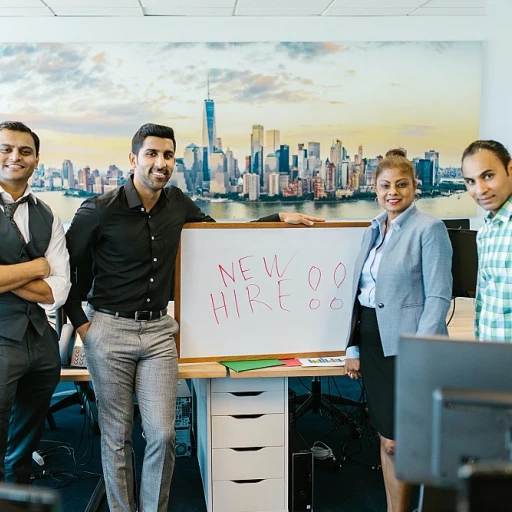Defining Staff Augmentation and Consulting
Clarifying the Concepts of Staff Augmentation and Consulting
Understanding the nuances between staff augmentation and consulting is key for businesses seeking the most effective approach to project management and team development. While both involve bringing external professionals into a company, they serve distinct purposes that align with specific business needs. Staff augmentation is a flexible outsourcing strategy where companies hire external professionals to fill short-term or long-term gaps in their workforce. This approach is particularly beneficial for companies needing to expand their team for specific projects without the expense of hiring full-time employees. It allows businesses to augment their existing personnel with individuals who bring expertise in software development, project management, and other domains. For example, augmentation services offer an efficient way to access specialized skills for a precise term, whether it's for a few months on a project-based assignment or for ongoing development tasks. On the other hand, consulting services provide strategic guidance and insights from experienced consultants. These professionals offer their expertise to help businesses navigate complex challenges and drive growth. Consulting can be project-based or part of a longer-term partnership, focusing more on advising and planning than on the actual execution of tasks. It enables companies to leverage external knowledge and tap into valuable networks, giving them a competitive edge. Both approaches have their merits, and the decision between them often hinges on factors such as flexibility, control, and cost implications. Companies must weigh the benefits of augmented staff to fill immediate needs against the longer-term benefits of consulting services that can drive strategic change. To further explore how these approaches align with the evolving job market, understanding reskilling opportunities can offer valuable insights. Explore more about how these opportunities shape the workforce here.Reskilling Needs in Staff Augmentation
Addressing Reskilling Demands in Augmented Teams
In today's dynamic business environment, the increasing demand for reskilling within staff augmentation services is becoming evident. Unlike traditional employment models, staff augmentation allows companies to hire external professionals with specific expertise for a set time and project-based needs. While this model offers flexibility, it also presents a unique set of challenges and opportunities for reskilling. Reskilling in staff augmentation revolves primarily around integrating external professionals with existing in-house teams. This integration is crucial for seamless project development and ensuring that augmented staff can adapt quickly to company-specific needs and technologies. As businesses are navigating through various stages of software development and project management, the need for a skilled workforce that can adapt to changing technological landscapes is more critical than ever. Here are some key points to consider:- Defining Training Targets: Before bringing onboard any staff or augmentation service, it's essential to determine the skill gaps within your current teams and identify what specific skills the augmented staff will need to bridge these gaps.
- Tailored Training Programs: Augmented staff often requires customized training to align with company-specific procedures, work culture, and project requirements. By offering project-based reskilling initiatives, businesses can ensure that the staff is well-equipped for short term, project-specific work up to long term collaborations if needed.
- Continuous Development: Reskilling should not be a one-off event. Continuous learning and development plans will help maintain a competitive edge and allow teams to adapt to advancing technology, especially in fast-evolving fields such as software development.
Reskilling Strategies in Consulting
Strategies for Enhancing Skills in Consulting Teams
Consulting services often involve assembling a team of experts who possess diverse skills tailored to solve complex business problems. Therefore, reskilling in this context focuses on specific, project-based requirements. Companies rely on consultants to provide timely expertise, making it essential to keep the consulting team’s skills up-to-date and relevant. Consultants typically work on a project-by-project basis, driving the need for constant adaptation. As software development and other project-driven industries evolve, so too must the knowledge base of these external professionals. To achieve this, firms implement several reskilling strategies:- Investment in Continuous Learning: Consulting companies often invest in ongoing training programs to ensure their teams have the cutting-edge skills required for new projects. By providing access to the latest workshops, certifications, and seminars, consultants can maintain their competitive edge.
- Collaborative Initiatives: Developing partnerships with educational institutions or industry associations can offer consultants unique learning opportunities. These collaborations often result in specialized training sessions focusing on emerging trends and technologies.
- Utilization of Augmented Staff: For short-term projects, augmentation services can bring in professionals with specific expertise. This is not only cost-effective but also ensures that the in-house team can focus on long-term strategic goals.
- Peer Learning and Mentorship: Encouraging knowledge sharing through mentorship programs allows consultants to glean insights from seasoned experts. This not only enhances their skills but also builds a cohesive consulting staff capable of tackling diverse challenges.
Comparing Flexibility and Control
Balancing Flexibility and Control in Staffing Solutions
When comparing staff augmentation and consulting, a key difference lies in the flexibility and control provided to the business. Each approach offers its own advantages, depending on the company's specific needs and project goals.
Staff augmentation allows businesses to strengthen their existing in-house team with external professionals, providing additional expertise and capacity without long-term commitments. This approach is particularly beneficial for short-term projects or when there is a need for specialized skills that are not available internally. Companies can maintain control over their projects since the augmented staff works alongside full-time employees, adapting to the company's culture and project management practices.
In contrast, consulting services offer a different kind of flexibility. Consulting firms typically bring a project-based approach, delivering specific solutions by leveraging their team of experts. This can be advantageous when a business requires comprehensive support to address complex challenges, whether in software development or other domains. By hiring consultants, companies benefit from external insights and methodologies, which can drive innovative solutions and strategic development.
When weighing these options, it's important to consider the desired level of control. Staff augmentation provides more direct oversight of the augmented staff, as they integrate closely with the internal team. Companies can leverage this increased control to ensure alignment with their processes and objectives, while still benefiting from the additional expertise brought by augmented staff.
On the other hand, consulting staff often operate with greater autonomy. This allows consulting companies to implement their tried-and-tested strategies efficiently and effectively, thereby providing value quickly. However, some businesses may feel they relinquish a degree of control, as they rely on the consultant's expertise and project management systems.
Ultimately, the choice between these staffing solutions should be based on the desired balance of flexibility, control, and the specific nature of the business's project or long-term objectives. Both augmentation and consulting present valuable opportunities for companies seeking growth and competitive advantage through innovative staffing strategies.
Cost Implications of Reskilling
Financial Aspects of Reskilling
When businesses examine the financial implications of reskilling, they discover a multifaceted investment that varies greatly between staff augmentation and consulting models. Both methodologies offer unique financial considerations that influence overall cost-effectiveness, hiring practices, and project success.
In staff augmentation, businesses often seek to fortify their in-house team with external professionals who possess specific expertise. Companies pay for the exact time these augmented staff work, making it a cost-effective solution for short-term projects or when full-time hiring isn't feasible. This flexibility allows for dynamic scaling of project-based teams, minimizing overhead expenses associated with long-term employment.
Conversely, consulting services typically entail contracting external professionals or consultants to deliver expertise over a predetermined period or project term. This model may initially seem more expensive due to consulting fees, but it offers structured guidance and comprehensive project management often tailored to complex business needs. The investment in consulting services can lead to substantial long-term savings by streamlining project execution, uncovering new opportunities, and optimizing business processes.
When deciding between augmented staff and consulting staff, businesses must consider their financial capacity and specific needs. Factors such as the length of the engagement, the need for bespoke development, and the level of control and flexibility required play a significant role in determining the most cost-effective and beneficial approach.
Ultimately, understanding the nuances of each approach equips businesses to make informed decisions, positioning them to maximize the return on their reskilling investments. As these models evolve, staying aware of cost implications and how they align with business goals remains pivotal.
Choosing the Right Approach for Your Business
Determining the Best Fit for Your Workforce Needs
Choosing the right approach between staff augmentation and consulting can significantly impact how well your business adapts to current and future demands. The decision largely depends on a combination of factors including your project requirements, timeline, budget, and the specific expertise needed. When considering staff augmentation, think about whether you need a more flexible and short-term solution to fill skill gaps on an ongoing basis. This approach provides the ability to bolster your in-house team with augmented staff who can seamlessly integrate into your existing workflow. It especially benefits companies that require a speedy scale-up of their workforce for specific projects, without the long-term commitment to full-time hires. However, do weigh the trade-offs in terms of control and potential longer-term costs. On the other hand, if your business requires a strategic overhaul or robust development of a new capability, consulting services may be the answer. Consulting involves hiring external professionals who bring a wealth of expertise and fresh insights. This can be particularly valuable for complex projects or when launching new initiatives, where guidance from seasoned consultants can lead to better outcomes. Consulting often provides comprehensive project-based solutions but might entail higher upfront costs. To determine your business's best course of action, consider the following:- Project Scope and Complexity: For well-defined, short-term projects with clear deliverables, staff augmentation might suffice. For multifaceted or transformative projects, consulting services offer the strategic depth you might need.
- Cost Considerations: Evaluate the upfront costs against long-term benefits. Augmentation can be more cost-effective initially but may incur higher costs if used for extended periods.
- Control and Management: Decide how much control you need over the day-to-day tasks. Staff augmentation provides more direct oversight, whereas consulting typically cedes some control to the consulting party.
- Long-term vs. Short-term Needs: Assess whether your requirements are time-sensitive and short-term or if there's a continual need for skill development and adjustments.





